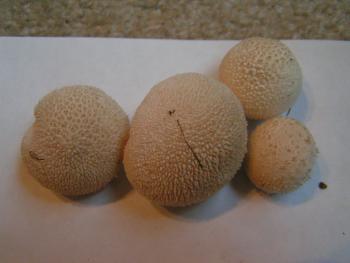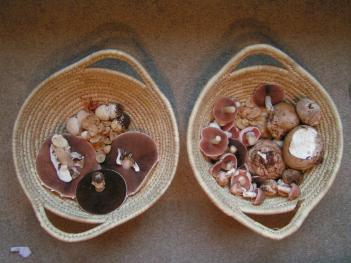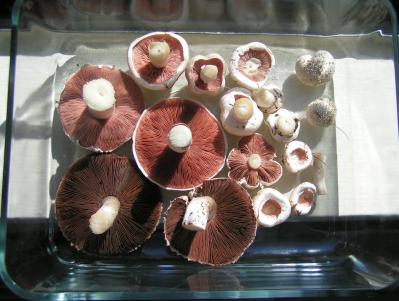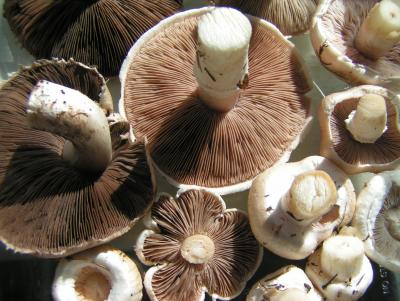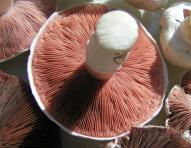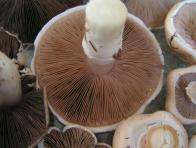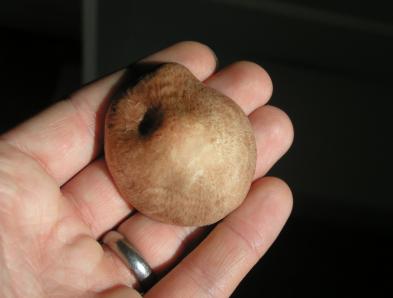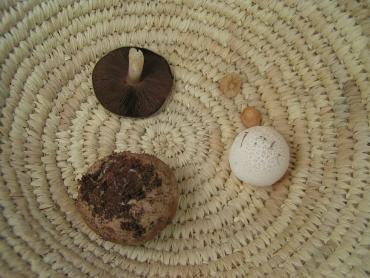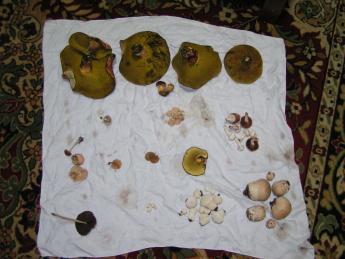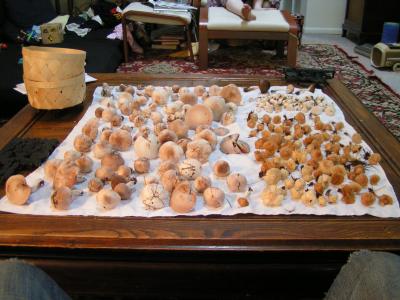Some Lycoperdon (either L. pulcherrimum or L. echinatum).
UPDATE (Oct 13 ’10): Vacellum curtisii
Category Archives: Puffballs
October 25 Catch
I was surprised to bring in so many mushrooms at this time in the season. The weather has been whacky, so I’ll blame that. Below are some pictures of the two baskets that my wife and I brought in. I only wish that there was better light to take the photographs in as most of them came out grainy.
I’ll be going through each type of mushroom we came across in separate entries.
-Steve
After Some Much-Needed Rain
We haven’t had rain in too long, so when I had a whopper of a headache on Wednesday night, I was a little excited. Sinus headaches for me have always been followed by changes in the weather, but more specifically, rain, so sure enough on Thursday it started to drizzle, and on Friday it turned into a full-blown downpour. The next day afterwards, my wife and I went out mushrooming and pulled in a good-sized catch. Not as large as we had hoped, but a relatively large for how late in the season it’s getting.
Yesterday, we brought in the above: 15 Agaricus campestris and two Lycoperdon (either L. pulcherrimum or L. echinatum, I can never really tell not that it really matters to me). I popped these into the fridge overnight to outline that change of gill color that I had mentioned before. Within a few hours after they are picked, the characteristic bright-pink of the gills fades to a pallid gray:
This is completely normal, but a really good reason to keep a mushroom journal with photos. In the past, I’ve thrown out entire clutches of campestris because I was not aware of this quirk and feared misidentification (as if I’m not 100% confident that a mushroom is edible, I toss it: “When in doubt, throw it out!”).
Another thing that I loved about this batch of campestris was that most of them were of the brown-capped variety:
Just like Agaricus bisporus, the mushrooms you get in the supermarket, have “white” (button) and “brown” (portobello, crimini) varieties, so to A. campestris. I love their color.
The next day (today) we went out again only to find slim pickings, albeit with a bit more variety:
One mature Agaricus campestris, two Marasmius oreades, one Lycoperdon, and one Calvatia (probably C. cyanthiformis).
I’ll post more soon.
Peace,
-Steve
August 26 ’07 – Lot 13
August 26 ’07 – Lot 12
A beautiful assortment of Lycoperdon. I’ll be buggered if I can figure out which species, though. Because the spines are not circular and the points of them tend to stick together in clusters of three or four they’re probably either Lycoperdon pulcherrimum or young Lycoperdon echinatum.
UPDATE: They are Vascellum curtisii (aka. Lycoperdon curtisii).
August 26 ’07 – Lot 11
August 26 ’07 Mushroom Hunt
Wow… what a bounty. On a whim Nayla and I decided to go on a mushroom hunt to pull in some of our regular Agaricus campestris, Marasmius oreades, and possibly some assorted Puffballs, but we brought many more different varieties than we expected. 🙂
Here’s the total below. I’ll be adding in detailed entries as I set them up for spore prints. I figure that this blog is the best method to keep a mushroom journal.
First Row: 7 blue-staining Boletes of unidentified variety (5 mature, 2 buttons)
Second Row: 1 unidentified white mushroom growing on debris, a handfull of Marasmius oreades (Fairy Ring Mushroom) caps, 8 small Agaricus campestris (Meadow Mushroom).
Third Row: 3 unidentified field mushrooms, 1 unidentified field mushroom (possibly the same as the first, but different stem color), 1 Gyrodon merylioides (Ash Bolete).
Fourth Row: 1 unidentified Psathyrella(?), 5 small assorted Puffballs, 11 Lycoperdon, 6 Calvatia.
And then there are 6 possible Agaricus of some persuasion or another, but there are some features that may prove otherwise.
Details coming soon!
The Mushroom Holiday
After exceptional rain, the Caruso Family of (at least for now) Highland Park declares a Family Holiday to go mushroom hunting. Yesterday was such a holiday where we brought in nearly 5 pounds of fresh edible mushrooms, with another 2 pounds collected today. Here are some pictures:
Agaricus campestris on the left, Marasmius oreades in the front right, and in the back right various Puffballs.
This Holiday stemmed from wife Nayla and I regularly engaging in amateur mycology and our love for filling baskets full of edible shrooms for lunch and dinner. Our first hunt for a mushroom’s identity was when we were dropping my younger sister Liz off back at my father’s house and we came across this gigantic mushroom growing up right out of where a former maple tree once stood. We grabbed it, took it home, and were curious as to what it could possibly be. It was nearly 9 inches tall, a full 8 inches in diameter with big shaggy spots on the cap with white gills and the remnants of a ring.
After poring over the internet and books from the library, we were able to narrow it down to one of three varieties:
Candidate #1 was the Parasol Mushroom. A choice edible with a delicious flavor. We were very hopeful.
Candidate #2 was the Shaggy Parasol. All the parasol, but… shaggier. Ours was less shaggy than a Shaggy Parasol, but more shaggy than a Parasol, so it was a possibility. This mushroom, too is a choice edible. Our mouths watered.
Candidate #3 was the False Parasol mushroom, Chlorophyllum molybdites. It looks identical to either the Parasol Mushroom or the Shaggy Parasol, but it is responsible for the most mushroom poisonings annually in North America.
Eek.
Luckily, there was one surefire way to tell whether our specimen was a False Parasol for sure: False Parasols have green spore prints where both Parasols and Shaggy Parasols’ are white. We immediately set things up for a spore print and left it overnight just to be sure.
Our hearts sank when the print came back green. Nothing to eat here.
But no matter. We saved ourselves hours of gastro-intestinal distress and taught ourselves a very valuable lesson: If you hunt any mushrooms at all, always always always do your research. That was a close call, and if we didn’t take the time we did, we would have run into trouble.
Too many people in the US have come across False Parasols and didn’t take the time to check the spore print before gobbling them down. The result? A 6-hour stretch of violently ill bowels and vomiting. Beautiful. And what if they had picked up one of the more serious mushrooms like a deady Amanita? A frightful thing to think about.
However, here are some interesting statistics. Michael W Beug (the Chair of the North American Mycological Association‘s Toxicology Committee) did a survey of nearly 2000 cases of reported mushroom poisonings between 1984 and 2003. He commented that he was surprised at how unusual it was for a human to die from ingesting poisonous mushrooms:
The most striking aspect of all of the reports was how rarely a human died from a mushroom ingestion. Even people who ate one of the deadly Amanita species usually survived (though often with significant liver damage). In fact, the two cases of human deaths in Canada or the United States in the past three years where mushrooms were eaten shortly before death of the individual were not attributed to consumption of mushrooms, but were clearly due to other causes.
He also states:
Compared to going out and randomly eating plants in the woods and in flower beds, eating wild mushrooms is quite safe. Only about 10% of all mushrooms are poisonous, and only about 10% of the poisonous species are potentially deadly. Plant toxins are far more common, more often deadly, and generally much faster in their action. The difference is that people usually do not go around randomly sampling plants growing in flower gardens or in the wild, while they do eat mushrooms that they have not identified and may not even have a clue as to how to properly identify. They also eat mushrooms that are spoiled, where plants in a similar state of decay would have been discarded.
In some of the other reports, they discuss how the people who were killed simply did not do their homework before making a meal out of unidentified fungus.
So think about it this way. When in doubt: Throw it out! Would you be willing to take a bite of something, chew and swallow when you weren’t sure of what it is? Unless you’re 100% certain about a mushroom’s identification I don’t think that it is a very good long-term investment to ingest it.
